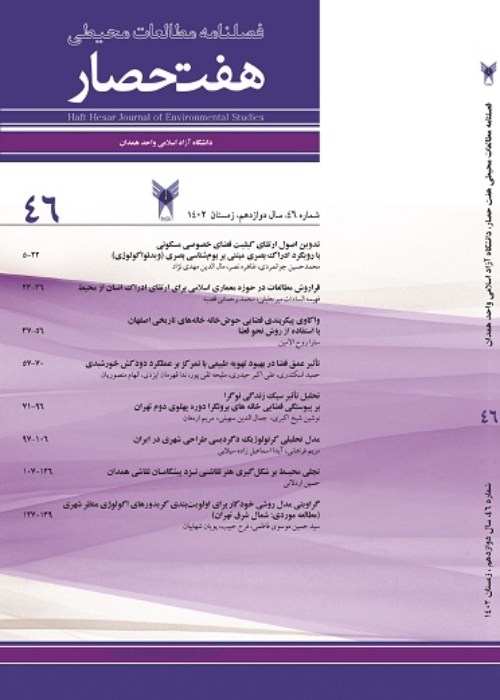The manifestation of the environment on the formation of the art of painting by the pioneers of painting in Hamedan
To perceive and recognize the beauty through the artists’ eyes in concert with the life appearance, requires confiding in the artists’ sensibility and paying attention to the intended era historic monuments. Hamedan is a city enjoying such a long historical and cultural continuation. Literature aside, Hamedani artists have adored visual arts more than any other realm of art. This very article strives to consider and classify the latent currents among Hamedan first-generation painters. In other words, it endeavors to introduce, categorize, and analyze the available flows from artists’ artworks from the beginning of painting creation on canvas and cloth for Hamedan artists-painters born (Hijri Shamsi 1280-1330), concentrating on the notion of appearance (far and near). Almost always, the artist seeks refuge in nature to understand himself and the connection between feeling and imagination. Henceforth, art, in a sense, adheres to an understanding of the world that takes humanity away from all its functions at the level of society for a moment to reach a status of imagination and pure feeling with a special sensitivity. Man, therefore, can achieve an understanding and transformation of nature under the umbrella of imagination and explicit sensations.
The article data collection method has been field and library collection method making use of document reading, taking notes, observation, and interviews. The works analysis method has been done through the descriptive method, their critique based on form analysis (composition or structure, form, and color), and the stylistics of some of the artists’ works through comparative content analysis.
The research findings show that almost five parallel flows have loomed in painting art within Hamedan first-generation painters: Kamalolmolk school painters, naturalist painters, miniature and national art, religious painters and coffee house, modernist painters, each of which owes a great deal to their taking notice of Hamedan nature. The common denominator among the intended painters in this article is being affected by Hamedan and affecting Hamedani art fans.
It seems that Kamalolmolk school artists and naturalist painters make use of moderate compositions and presumably classic ones. Although nature can be the main concern of the painting, it would be categorized under the rubric of the modernist painting. The compositions from the vantage point of the naturalist painters and miniaturists obtain consequential plans with circulative forces in the particular pictures and perspectives which are formulated according to the so-called styles. Among religious and coffee house school painters, the intertwined forms and consequential images, in a sense, make attempts to introduce a story within a plan. For a reason as such, there resides no visual breathing in the work and the positional perspective is made use of. Ultimately, the composition type to modernist painters’ viewpoint attains the shallow depth of field and pictures in a closed frame.
- حق عضویت دریافتی صرف حمایت از نشریات عضو و نگهداری، تکمیل و توسعه مگیران میشود.
- پرداخت حق اشتراک و دانلود مقالات اجازه بازنشر آن در سایر رسانههای چاپی و دیجیتال را به کاربر نمیدهد.


